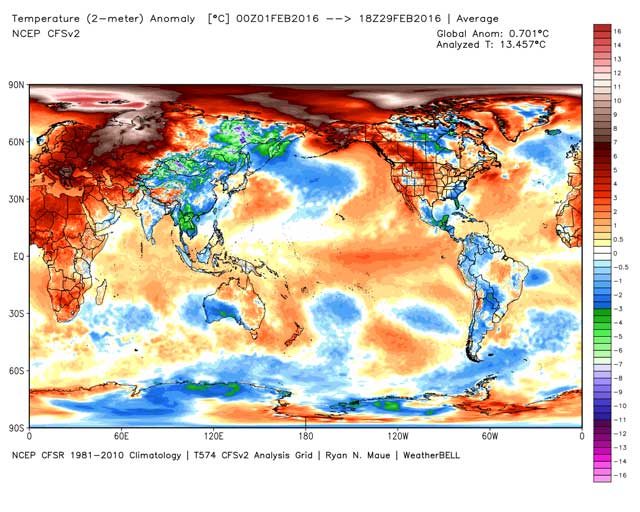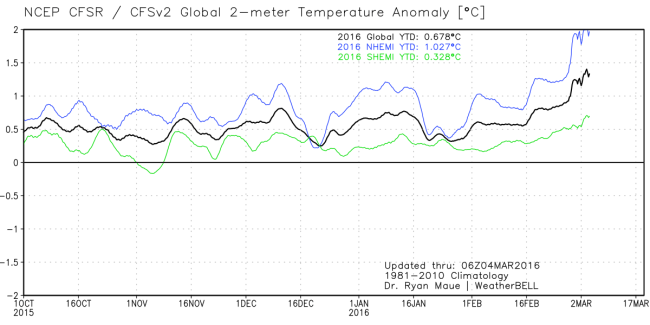 It has long been advocated that we need to avoid dangerous climate change by keeping the global average temperature rise under 2 degrees, and up until October 2015 that appeared to be viable. Unfortunately since then there has been a very dramatic change, the temperature rise has suddenly accelerated and as a result, January was a record breaking month surpassing anything previously measured, but then February happened to us and that blew away the January records.
It has long been advocated that we need to avoid dangerous climate change by keeping the global average temperature rise under 2 degrees, and up until October 2015 that appeared to be viable. Unfortunately since then there has been a very dramatic change, the temperature rise has suddenly accelerated and as a result, January was a record breaking month surpassing anything previously measured, but then February happened to us and that blew away the January records.
As explained in great detail by Eric Holthaus, a meteorologist within an article on 1st March …
Keep in mind that it took from the dawn of the industrial age until last October to reach the first 1.0 degree Celsius, and we’ve come as much as an extra 0.4 degrees further in just the last five months. Even accounting for the margin of error associated with these preliminary datasets, that means it’s virtually certain that February handily beat the record set just last month for the most anomalously warm month ever recorded. That’s stunning.
It also means that for many parts of the planet, there basically wasn’t a winter. Parts of the Arctic were more than 16 degrees Celsius (29 degrees Fahrenheit) warmer than “normal” for the month of February, bringing them a few degrees above freezing, on par with typical June levels, in what is typically the coldest month of the year. In the United States, the winter was record-warm in cities coast to coast. In Europe and Asia, dozens of countries set or tied their all-time temperature records for February. In the tropics, the record-warmth is prolonging the longest-lasting coral bleaching episode ever seen.
Oh but wait, that was 1st March, and since then things have been heating up even further very rapidly, so much so that we breached the famous 2 degree mark at around the 2nd March in the northern hemisphere (below is the latest update for yesterday 5th March)
The Magic 2 Degrees
It was the supposed long term goal of the various climate agreements to hold us to this, and was of course simply a line in the sand that was meant to be “here and no further”. The message was that going beyond that line was dangerous …
Limiting the average global surface temperature increase of 2 °C (3.6 °F) over the pre-industrial average has since the 1990s, been commonly regarded as an adequate means of avoiding dangerous climate change, in science and policy making.[15][16] In 2005 an international conference called “Avoiding Dangerous Climate Change: A Scientific Symposium on Stabilisation of Greenhouse Gases”[17] examined the link between atmospheric greenhouse gas concentration, and the 2 °C (3.6 °F) ceiling on global warming thought necessary to avoid the most serious effects of global warming.[18] Proceedings of the symposium were published in 2011, in an open-access special issue of the Royal Society’s Philosophical Transactions A.[19]
… but we are suddenly a lot closer a lot faster.
OK, sanity check, not quite there on a global scale. The chart above has 3 lines …
- Blue – The Northern half the planet – we have reached the 2 degree mark there
- Green – The Southern half of the planet – not yet at one degree
- Black – the global average – close to 1.4
What is clear is that there has been a very sudden dramatic spike, and we do already see symptoms of that. For example the extent of the winter ice coverage in the Arctic is the lowest ever recorded, and the antarctic numbers for the summer minimum are also the lowest.
Something very dramatic is happening right now, and nobody knows what will now come next.
“The old assumptions about what was normal are being tossed out the window … The old normal is gone.” – Peter Gleick, a climate scientist at the Pacific Institute in Oakland, California
Links
To see a chart showing you the daily updated global temperatures using raw NCEP CFSv2 data – go here to Ryan Maue’s page
To see a chart giving you the daily updated cover of sea ice in the arctic and antarctic – go here
Special Note
The numbers are early preliminary numbers, we get the official number in a few weeks.

Does this mean I should quit my job, cash in my retirement, break out the lawn chair and sip on some cool ones while I wait for the coming meltdown of the planet. Better make sure I have plenty of ice.
What a load of baloney. 2 de g C is an arbitrary number that doesn’t really mean anything. The link between CO2 and global warming is tenuous at best and the evidence for a link between CO2 and climate change is even worse despite the revelations of the media and ignorant politicians. Show me a severe weather event occurring today that has not happened in the past pre-elevated CO2. As a scientist I am ashamed of those in the scientific community who allow this nonsense to continue. You are destroying our economies, taking our jobs, increasing our taxes and increasing the cost of all goods and services. What about the opposite point of view – atmospheric CO2 has been declining throughout earth’s history – 500 million years ago it was 5,000 to 6,000 ppm; 150 million years ago it was 2000 ppm and today it is a measly 400 ppm. What will happen if we stop using fossil fuels – will the CO2 levels continue to decline possibly to levels detrimental to plant life. My opinion – we can survive with elevated CO2 levels but not with less. I refuse to consider CO2 a pollutant.